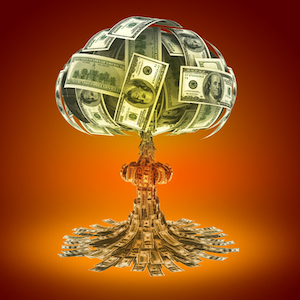By Dr. Ken Broda-Bahm:

In the most recent verdict against former President Donald Trump, the jury awarded quite a bit more than the plaintiff had asked for. In the case of the $83.3 million defamation award made to the writer, E. Jean Carroll, we have a special case: a defendant who did just about everything a defendant can do in order to provoke a large award. He took responsibility for nothing, showed that the motivating behavior was likely to continue, and conveyed a clear contempt for the judge and for the process. That specific message combination will, thankfully, apply to very few defendants. But the motivation to award high damages in more typical scenarios has become increasingly common.
That is the reality detailed in a new analysis released earlier this month by Tyson & Mendes attorney Madison Miller, with the heart-stopping title, “New Year, New Fear: Why Nuclear Verdicts Will Get Worse This Year.” In a nutshell, Miller makes the argument that eye-popping awards are likely to be the new normal. In this post, I will highlight some of the data and the social reasons for this that she shares, and emphasize one aspect of defense strategy that should be given greater prominence.
The Reality:
These are some of the sobering stats shared and cited in Miller’s article:
- Far outpacing inflation, median nuclear verdicts increased by 95% from $21.5 million in 2020 to $41.1 million in 2022.
- In 2022, there were twenty verdicts higher than $100 million.
- Nine out of ten nuclear verdicts occur in state rather than federal court.
- The top ten nuclear verdict states are Florida, New York, Pennsylvania, Illinois, California, Alabama, New Mexico, Georgia, Wyoming, and Texas.
- The litigation areas of products, auto accident, and medical liability make up two-thirds of nuclear verdicts.
- The industries most often targeted for nuclear verdicts are telecommunications, software, automotive, tobacco, semiconductors, health care, banks, and utilities.
The Reasons:
Miller joins many of those commenting on the rise in verdicts in emphasizing “social inflation,” or the condition in which bigger numbers just aren’t as shocking to the public as they once were. The jurors who react with “sticker shock” upon hearing a plaintiff’s request are still there, but they don’t seem to be as common, as loud, or as persistent as they once were. In addition, the target for the award matters as well. With a distrust of corporations now being a shared attitude by both the left and the right on the political spectrum, jurors — with or without a punitive option on the table — are more prone to see a large award as a way to punish and not just as a way to make a plaintiff whole. But perhaps the biggest reason for the trend toward higher verdicts is that plaintiffs are emboldened and are simply relying on the “anchoring effect” and asking for more.
The Recommendations:
The final and most important section of the Tyson & Mendes article focuses on how defendants can mitigate the risk of increasingly common outlier verdicts. Miller mentions companies taking a hard look at their crisis response and safety policies because a proactive approach can both reduce suits and serve as a foundation for a good defense. In addition, Miller also stresses the valuable point made in Robert Tyson’s Nuclear Verdicts book that defendants need to show that they are taking responsibility — not necessarily for liability, but more generally for safe and secure operations, and for meeting or exceeding the law and their own policies. Additional advice is to personalize the company, provide a reasonable benchmark for assessing the plaintiff’s damages, and giving a counter-anchor.
These are all good ideas, and part of a comprehensive strategy on arguing defense damages in a way that answers the current moment. But I believe it leaves out one critical factor, and that is to address what jurors see themselves as doing if and when they arrive at a number. Are they calculating an answer to a math problem, or are they using dollars to provide a response to a social problem? The difference comes down to motivations. Be sure that plaintiffs will devote a lot of thought to what would make jurors want to award a big number (anger, sympathy, revenge, punishment, etc.), so defendants should devote equal thought to what might motivate jurors to focus instead on what is more often the legally appropriate goal: to translate a plaintiff’s actual losses into fair economic terms. To encourage that mindset, defendants need to use every opportunity ingrain a mindset focused on calculation rather than on any broader “message.”
____________________
Other Posts on Combatting Nuclear Verdicts:
- Defense Damages Counter-Anchor: Get Them to Calculate, Not Speculate
- Defendants – Argue Damages Differently
- Ground Your Noneconomic Damages Anchor
____________________